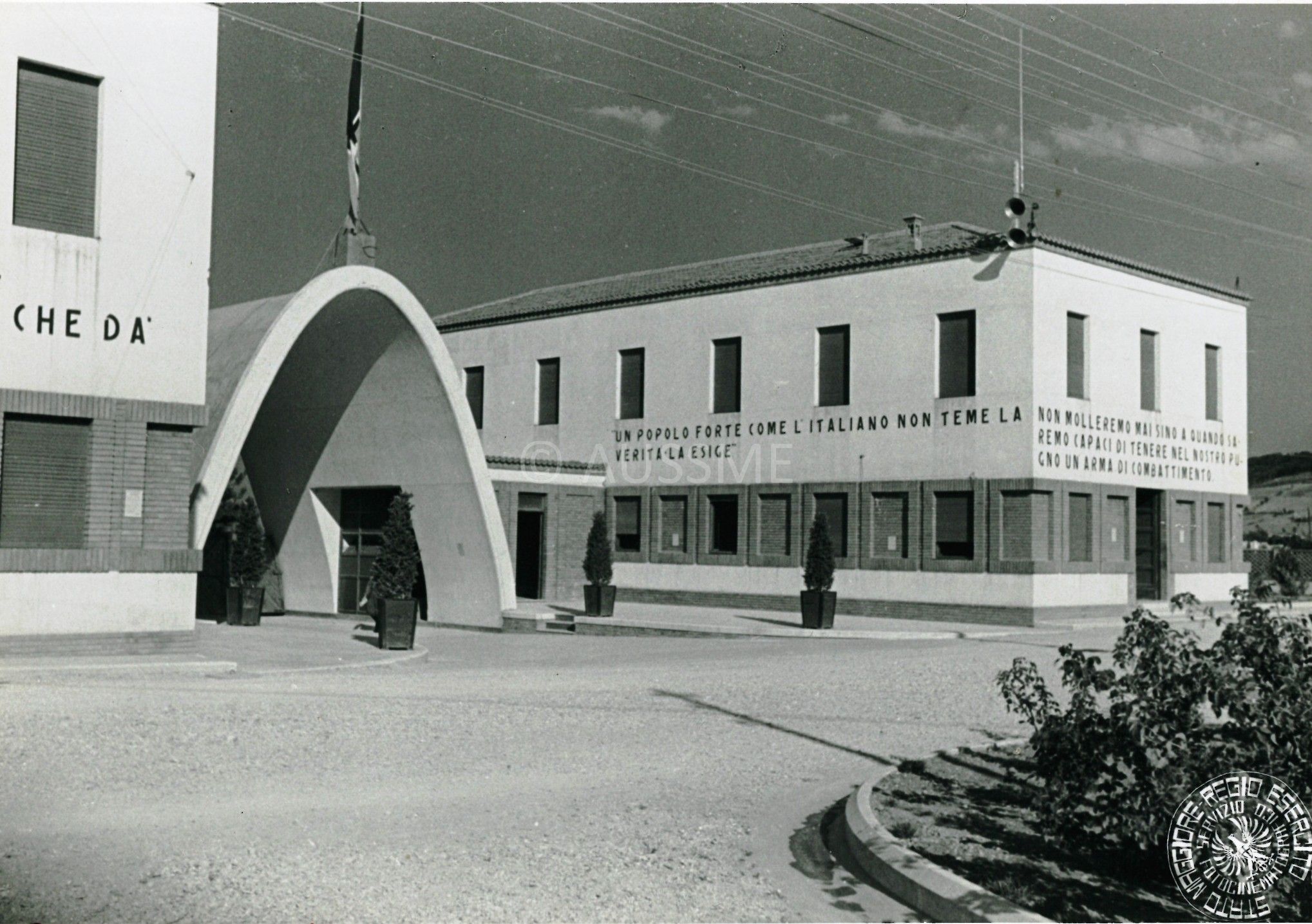Sheet by: Costantino Di Sante

Entrance and command building of concentration camp No. 53 Sforzacosta (MC) - AUSSME Archive, Fototeca 2 Guerra Mondiale Italia 507/647
General data
Town: Macerata
Province: Macerata
Region: Marche
Location/Address: Sforzacosta - Macerata
Type of camp: Prisoner of War camp
Number: 53
Italian military mail service number: 3200
Intended to: NCOs – Troops
Local jurisdiction: IX Army Corps
Railroad station: Urbisaglia-Sforzacosta
Accommodation: military quarters (tents)
Capacity: 8000
Operating: from 10/1942 to 15/09/1943
Commanding Officer: Col. Salvatore Cilotti (October 1942– July 1943); Col. Massimiliano Capurso (January – July 1943); Col. Enrico Getragnani (July – September 1943)
Brief chronology:
July 1942: beginning of the works to adapt the Sforzacosta linen mill warehouses to house PoWs.
22 September 1942: because of a rainstorm the planned PG 56 (tent encampment) was cancelled.
October 1942: the camp was opened.
23 February 1943: 150 PoWs were transferred from PG 65 Gravina.
23 February 1943: PoW Arthur Aaron was killed by a sentry.
July 1943: 1,750 PoWs were transferred to the Third Reich.
Allied prisoners in the Macerata camp
| Date | Generals | Officers | NCOs | Troops | TOT |
| 31.10.1942 | 111 | 1583 | 1694 | ||
| 30.11.1942 | 8 | 363[1] | 5132 | 5503 | |
| 31.12.1942 | 8 | 364 | 5133[2] | 5505 | |
| 31.1.1943 | 8 | 420 | 5951 | 5951 | |
| 28.2.1943 | 18 | 481 | 6476 | 6875 | |
| 31.3.1943 | 8 | 516 | 6826 | 7350 | |
| 30.4.1943 | 7 | 492 | 6587 | 7086 | |
| 31.5.1943 | 7 | 494 | 3450 | 3951 | |
| 30.6.1943 | 8 | 659 | 5552 | 6219 | |
| 31.8.1943 | 11 | 803 | 6623 | 7437 |
Camp’s overview
PG 53 Sforzacosta is referred to as «Urbisaglia» in the official documents. As a matter of fact, the camp was opened, in 1942, in Sforzacosta village (Macerata), adapting the local linen mill warehouses in a similar way to PG 70 Monturano. The confusion was due to the fact that, in the same zone, two different camps were being prepared: PG 53 in Urbisaglia, using the old linen mill, and PG 56 in Sforzacosta, as a tent encampment. However, PG 56 never opened because, during its construction, a rainstorm hit it on 22 September, causing damage and flooding the area. For this reason, the Army High Command ordered the tents to be dismantled and suspended the camp’s activities during winter. In the summer of 1943, the tents were reinstalled again. They housed the PoWs transferred from the closed southern camps in the area where PG 56 was supposed to be instituted. However, this new camp did not take its old name but was incorporated as a sector of PG 53. For these reasons and the proximity to the railroad station of Urbisaglia-Bonservizi, the Sforzacosta camp would be known as Urbisaglia in the official records.
According to the earlier projects, which probably included the tent encampment, the camp was supposed to hold 12,000 PoWs. However, even during the summer of 1943, when the new sector was added to the camp, its maximum capacity was only 8,000. The camp was surrounded by a wall that, together with six guard towers, prevented the PoWs from escaping. The two main entrances were shut by large wrought iron gates, which divided the camp into three sectors for the PoWs and one intended for the Italian personnel. The PoWs could access, besides the areas for roll call, some communal areas to carry out recreational activities and the nearby fields to practise sports.
The camp was officially opened in October 1942, as the works to adapt part of the old structures were still going on. The dormitories were never appropriately heated, the buildings lacked enough windows, and the wall, made of concrete, tended to fall apart. The firm in charge of the works used shoddy materials, and even the roofs cracked. The sewage system was poorly built, just like the plumbing, which could not maintain a steady water flux, making showering difficult for the PoWs. Some of these problems were never resolved. It is not surprising that Sforzacosta was considered by the Allies one of the worst permanent Prisoner of War camps in Italy.
Because of the cold, the insufficient clothing, and the poor sanitary conditions, many PoWs fell ill and out of the 52 deaths registered between November 1942 and May 1943, 39 were caused by pneumonia. But there were also deaths caused by malnourishment or dysentery. During the spring of 1943, as the camp was overcrowded again, the dormitory became infested by bedbugs, lice and fleas.
In May 1943, at least 3,000 prisoners were sent to work detachments and work camps, especially in Northern Italy, while in July of the same year, three groups of PoWs were transferred to Germany. They were all technicians and specialised workers selected from the camps of Sulmona, Servigliano, Monturano and Sforzacosta (the latter functioned as a transit camp for these PoWs). The first group, comprising 800 prisoners, left on 19 July. A further 800 were transferred on the next day, and 150 on the 21st. Some of them were deported as far as Estonia according to some sources.
However, the camp did not remain underused for long despite these transfers. In a few days, new PoWs were transferred there from the closed camps of Gravina and Capua and the work camp of Foggia. These brought the camp to its upper capacity, as it housed 7,437 PoWs by the end of August. Many new arrivals were ill with malaria, worsening the camp’s already precarious hygienic conditions.
The day after the Armistice, a group of prisoners attempted to organise an escape by removing a section of barbed wire but were stopped by the guards. On 15 September, taking advantage of the guards’ desertion, some PoWs managed to open the gates and disperse in the surrounding fields. At least 6,000 prisoners, however, remained in the camp and were eventually deported to Germany as the Germans took it over.
After the German occupation, PG Sforzacosta was turned into a camp intended for civilian internees. It held Jews who had already been interned in nearby provincial camps, forced labourers, deserters and anti-fascists who were later deported to the Nazi lagers.
In March 1946, the camp’s commander, Col. Massimiliano Capurso, and Private Clemente Fantacci were sentenced to eight and 15 years of prison, respectively, for the murder of prisoner Arthur Aaron, on 24 February 1943. However soon afterwards, the sentence against Capurso was nullified, and Fantacci had seven years remitted.
After the Liberation, the camp was abandoned, and the local population took away many materials. Later, some of the warehouses were given to private ownership. Today, the buildings are used mainly as garages for the local mechanical workshops.
On 30 June 2003, the Macerata township placed a plaque on the outer wall to remember the PoWs and the internees who were there during the war.
Archival sources
- Archivio Apostolico Vaticano, IAC, UIV, Sez. Segr., b. 518, f. 29
- Archivio Centrale dello Stato, Ministero dell’Interno, Direzione Generale Pubblica Sicurezza, A5G, II GM, bb. 116, 117, 118 e 140, Verbali e Notiziari della Commissione Interministeriale per i Prigionieri di Guerra
- Archivio Centrale dello Stato, Ministero dell’Aeronautica, Gabinetto, b. 70, Verbali e Notiziari della Commissione Interministeriale per i Prigionieri di Guerra
- Archivio di Stato di Ascoli Piceno, Fondo Questura. Divisione Gabinetto Cat. A13 B, bb. 2, 3
- Archivio di Stato di Ascoli Piceno, Fondo Comune Prefettura, bb. 38, 70
- Archivio Ufficio Storico Stato Maggiore dell’Esercito, L10, b. 32
- Archivio Ufficio Storico Stato Maggiore dell’Esercito, DS dello Stato Maggiore Regio Esercito-Ufficio Prigionieri di Guerra, bb. 740, 840, 843, 1130
- Archivio Ufficio Storico Stato Maggiore dell’Esercito, H8, b. 79
- The National Archives, WO 224/120
- The National Archives, WO 344/9/1
- The National Archives, WO 224/179
- The National Archives, WO 224/130
- The National Archives, WO 311/319
- The National Archives, WO 344/3/2
- The National Archives, TS 26/95
- The National Archives, TS 26/747
- The National Archives, TS 26/99
- The National Archives, WO 311/1204
- The National Archives, TS 26/753
Bibliography
- Absalom R., A Strange Alliance. Aspects of escape and survival in Italy 1943-45, Firenze, Olschki, 1991 trad. it. L’alleanza inattesa. Mondo contadino e prigionieri alleati in fuga in Italia (1943-1945), Bologna, Pendagron, 2011
- Broadbent G., Behind enemy lines, Bognor Regis, Anchor, 1985
- Cegna A. (a cura di), Balilla Bolognesi diari di un deporttao (25 lgulio 1943 – 26 luglio 1945), Ancona, Affinità elettive, 2004
- Cheetham J. , Italian Interlude. The experiences of a prisoner-of-war in Italy July 1942-June 1944, s.l., s.n., [2000]
- Di Sante C., L’internamento civile e i campi di concentramento nelle Marche, in P. Giovannini (a cura di), "L’8 settembre nelle Marche. Premesse e conseguenze", Ancona, Il Lavoro Editoriale, 2004
- Ellis R., (a cura di M.G. Camilletti) , Al di là della collina. Memorie di un soldato inglese prigioniero nelle Marche, Ancona, Affinità Elettive, 2001
- Harris G., Prisoner of war and fugitive, Hampshire, Gale and Polden Ltd, 1947
- Insolvibile I., I prigionieri alleati in Italia 1940-1943, tesi di dottorato, Dottorato in "Innovazione e Gestione delle Risorse Pubbliche", curriculum “Scienze Umane, Storiche e della Formazione”, Storia Contemporanea, Università degli Studi del Molise, anno accademico 2019-2020,
- Millozzi G. , Prigionieri alleati. Cattura, detenzione e fuga nelle Marche, 1941-1944, Perugia, Uguccione Ranieri di Sorbello Foundation, 2007
- Voigt K., Il rifugio precario. Gli esuli in Italia dal 1933 al 1945, vol. II, Firenze, La Nuova Italia, 1993
